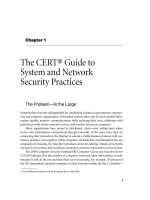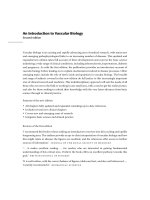Basic guide to system safety, 3rd edition
Bạn đang xem bản rút gọn của tài liệu. Xem và tải ngay bản đầy đủ của tài liệu tại đây (2.76 MB, 249 trang )
www.it-ebooks.info
www.it-ebooks.info
Basic Guide to
System Safety
www.it-ebooks.info
www.it-ebooks.info
Basic Guide to
System Safety
Third Edition
Jeffrey W. Vincoli
Manager of Environmental, Safety,
and Health Compliance Assurance and Support Services
Bechtel Global Corporation
www.it-ebooks.info
Copyright © 2014 by John Wiley & Sons, Inc. All rights reserved.
Published by John Wiley & Sons, Inc., Hoboken, New Jersey.
Published simultaneously in Canada.
No part of this publication may be reproduced, stored in a retrieval system, or transmitted in any form or
by any means, electronic, mechanical, photocopying, recording, scanning, or otherwise, except as
permitted under Section 107 or 108 of the 1976 United States Copyright Act, without either the prior
written permission of the Publisher, or authorization through payment of the appropriate per-copy fee to
the Copyright Clearance Center, Inc., 222 Rosewood Drive, Danvers, MA 01923, (978) 750-8400, fax
(978) 750-4470, or on the web at www.copyright.com. Requests to the Publisher for permission should
be addressed to the Permissions Department, John Wiley & Sons, Inc., 111 River Street, Hoboken, NJ
07030, (201) 748-6011, fax (201) 748-6008, or online at />Limit of Liability/Disclaimer of Warranty: While the publisher and author have used their best efforts in
preparing this book, they make no representations or warranties with respect to the accuracy or
completeness of the contents of this book and specifically disclaim any implied warranties of
merchantability or fitness for a particular purpose. No warranty may be created or extended by sales
representatives or written sales materials. The advice and strategies contained herein may not be suitable
for your situation. You should consult with a professional where appropriate. Neither the publisher nor
author shall be liable for any loss of profit or any other commercial damages, including but not limited to
special, incidental, consequential, or other damages.
For general information on our other products and services or for technical support, please contact our
Customer Care Department within the United States at (800) 762-2974, outside the United States at (317)
572-3993 or fax (317) 572-4002.
Wiley also publishes its books in a variety of electronic formats. Some content that appears in print may
not be available in electronic formats. For more information about Wiley products, visit our web site at
www.wiley.com.
Library of Congress Cataloging-in-Publication Data:
Vincoli, Jeffrey W., author.
Basic guide to system safety / Jeffrey W. Vincoli. – Third edition.
p. ; cm.
Includes index.
ISBN 978-1-118-46020-7 (hardback)
I. Title.
[DNLM: 1. Occupational Health. 2. Safety. 3. Safety Management. WA 485]
T55
658.3′ 82–dc23
2013051270
Printed in the United States of America.
10 9 8 7 6 5 4 3 2 1
www.it-ebooks.info
To my loving wife, Rosemary
Of all my accomplishments in this life, my greatest achievement was
convincing you to be my wife. After more than 30 years together, I do not know
how people go through life alone. I am blessed in many ways, but none more than
having you as my wife. Thank you for always being there with your patience,
your charm, your perspective, and your love. You are and will always be the most
cherished thing about my life.
www.it-ebooks.info
www.it-ebooks.info
Contents
PREFACE
PART I
xiii
THE SYSTEM SAFETY PROGRAM
1 System Safety: An Overview
1
3
Background / 3
The Difference Between Industrial Safety and System Safety / 7
System Safety and the Assessment of Risk / 8
2 System Safety Concepts
15
Fundamentals / 15
The System Safety Process / 16
System Safety Criteria / 18
Hazard Severity / 18
Hazard Probability / 18
The Hazard Risk Matrix / 19
System Safety Precedence / 20
vii
www.it-ebooks.info
viii
CONTENTS
Cost and Risk Acceptance / 24
Quantitative Risk Assessment / 25
Principles of Risk Management / 27
Management Commitment / 27
3
System Safety Program Requirements
29
The Safety Charter / 29
Selling Safety to Management / 30
The System Safety Effort / 31
Closed-Loop Hazard Tracking System / 32
Accident Risk Assessment / 33
Mishap/Accident/Incident Reporting / 33
Facility Inspection Reports / 36
System Safety Analyses / 36
Life Cycle Phases and the System Safety Process / 36
Concept Phase / 37
Design Phase / 37
Production Phase / 37
Operations Phase / 39
Disposal Phase / 39
4
The Industrial Safety Connection
41
The Occupational Safety and Health Act / 41
The Human Factors Element / 43
Accident Prevention Through System Design / 44
The Process of Task Analysis / 47
The Job Safety Analysis and System Safety / 48
Guidelines for Preparing a Job Safety Analysis / 50
Signatures and Approvals / 56
Changes in Hazard/Scope / 56
System Safety: an Integral Part of the Overall Organization / 57
5
Probability Theory and Statistical Analysis
Introduction / 61
Probability / 62
Statistics / 64
Summary / 67
www.it-ebooks.info
61
CONTENTS
PART II SYSTEM SAFETY ANALYSIS: TECHNIQUES
AND METHODS
6 Preliminary Hazard Analysis
ix
69
71
Introduction / 71
The PHA Development Process / 72
The PHA Report / 78
PHA Example / 78
System Description / 79
System Operation / 80
Preliminary Assessment / 81
Evaluation of System Risk / 81
Summary / 90
7 Subsystem and System Hazard Analyses
91
Introduction / 91
The Subsystem Hazard Analysis Report / 92
SSHA Example / 93
System Description / 93
Evaluation of Subsystem Hazard Risk / 95
Summary / 98
8 Operating and Support Hazard Analysis
99
Introduction / 99
Ergonomics / 99
When to Perform the O&SHA / 101
O&SHA Example / 103
Scope and Purpose of the Example O&SHA / 103
Risk Assessment / 104
Risk Assessment 1: 1B / 106
Risk Assessment 2: 1A / 107
Risk Assessment 3: 2B / 107
Summary / 109
9 Energy Trace and Barrier Analysis
Introduction / 111
The Energy–Barrier Concept / 111
Uses of the ETBA / 112
www.it-ebooks.info
111
x
CONTENTS
Performing the ETBA / 112
The ETBA Worksheet / 113
ETBA Example / 114
System Description / 114
The ETBA / 114
Summary / 118
10
Failure Mode and Effect Analysis
119
Introduction / 119
Types of FMEAs / 119
Performing an FMEA / 120
The FMEA Report / 121
FMEA Example / 124
System Component/Subassembly Description / 124
System Operation / 128
Failure Mode(s) and Effect(s) / 128
Evaluation of Potential Subsystem or Component Failures / 129
Summary / 132
11
Fault or Functional Hazard Analysis
135
Introduction / 135
The FHA Process / 136
FHA Example / 137
System Description / 137
The FHA Process / 139
The FHA / 141
Summary / 143
12
Fault Tree Analysis
145
Introduction / 145
Qualitative and Quantitative Reasoning / 146
Constructing a Fault Tree / 146
Fault Tree Symbols / 147
FTA Examples / 150
Probability Values and the Fault Tree / 153
Summary / 156
www.it-ebooks.info
CONTENTS
13
Management Oversight and Risk Tree
xi
157
Introduction / 157
The MORT Analytical Chart / 158
MORT Use / 159
The MORT Event Tree / 160
Symbols / 160
MORT Analysis Example / 161
MORT Color Coding / 163
Procedure for MORT Analysis / 165
Summary / 165
14
HAZOP and What-If Analyses
167
Introduction / 167
Background / 168
Definitions / 168
Objectives / 169
Team Members / 169
Reference Data Requirements / 169
The Concept of “Nodes” / 170
Conducting the What-If Analysis / 171
What-If Analysis Steps / 171
The What-If Analysis Worksheet / 173
Conducting The HAZOP Study / 175
The HAZOP Worksheet / 175
The Analysis Report / 176
Summary / 177
15
Special Use Analysis Techniques
179
Introduction / 179
Sneak Circuit Analysis / 180
Types and Causes of Sneaks / 180
SCA Input Requirements / 181
Advantages and Disadvantages of the SCA / 181
Software Hazard Analysis / 183
Types of SWHA Techniques / 183
Summary / 185
Epilogue
187
www.it-ebooks.info
xii
CONTENTS
Appendix A
Sources of Additional Information/Training
189
Appendix B
Acronyms and Abbreviations
195
GLOSSARY OF TERMS
199
BIBLIOGRAPHY
223
INDEX
225
www.it-ebooks.info
Preface
The third edition of the Basic Guide to System Safety contains all of the content
of the previous editions, updated (where applicable) to reflect current industry practice. The first edition of the Basic Guide to System Safety was the first volume issued
in a series of Basic Guide books that focused on the topics of interest to the practicing
occupational safety and/or health professional. Other books in the Series include
the Basic Guide to Environmental Compliance, Basic Guide to Accident Investigation and Loss Control, and Basic Guide to Industrial Hygiene. Each book has been
designed to provide the reader with a fundamental understanding of the subject and
attempt to foster a desire for additional information and training.
In addition to updated content of the previous editions, the revised third edition of
the Basic Guide to System Safety introduces some system safety concepts not previously discussed to further expand upon the basic knowledge that is the cornerstone of
the Basic Guide Series. In this regard, the third edition contains a discussion on the
concept of Design for Safe Construction where the methods and techniques associated with the system safety discipline can be effectively utilized to identify, analyze,
eliminate, or control system hazards during the design phase of a construction project.
As with all analytical methods and techniques presented in this text, it is suggested
that the concept of design for construction safety has definite application to general
industry operations.
Also, information on the use of the various methods and techniques associated with
the use of system safety has been expanded in the third edition to include guidance on
the evaluation and verification of compliance efforts following the implementation
of system safety analysis. This additional information will attempt to close-the-loop
on the effective use of system safety analysis in the industrial safety environment.
xiii
www.it-ebooks.info
xiv
PREFACE
It should be noted from the onset that it is not and never has been the intention
of the Basic Guide to System Safety to provide any level of expertise beyond that of
novice. Those practitioners and users who desire complete knowledge of the subject
will not be satisfied with the information contained on these pages. It is not practical or
feasible to expect a “basic guidebook” to contain all possible technical information on
any subject, especially one as complex as system safety. However, those that require
or perhaps only desire a basic understanding of a field similar but distinctly separate
from their current area of specialization will find the third edition of Basic Guide to
System Safety a valuable reference source and introductory primer. It is also assumed
that those currently involved in the practice of system safety engineering and analysis
might find this material somewhat enjoyable and, at the very least, refreshing. Also,
professionals not directly involved in the system safety effort but who must work in
association with those that are, will also find this text useful.
Finally, although the books in the Basic Guide Series were always originally
intended for the practicing safety professional, the Series has been proven to be quite
useful as textbooks for introductory courses in numerous colleges and universities.
In this regard, the third edition will provide some additional fodder for enhancing
existing primer courses on the subject.
It has long been known by practicing safety and health professionals that organizations with excellent safety performance records have a well-rounded corporate policy
or at least a firmly established administrative posture that consistently emphasizes
the importance and value of working safely. The leadership of such organizations has
provided their strong (and intelligent) commitment in support of the safety effort.
Therefore, this text concentrates especially upon the concepts that all executives
should understand concerning the role that safety programs play in the successful
operation of a business. No less of a commitment is necessary to properly implement system safety into an already established occupational/industrial safety and
health program.
It is also recognized that, in order to achieve operationally safe system performance, system safety programs must be conducted with defined purpose, proficiency,
skill, and a sense of well-rounded responsibility to the needs of the organization that
the system safety program is intended to serve. In such a supportive environment, the
system safety effort can and will become a vital contributor to the overall success of
the enterprise.
This text places considerable emphasis on the integration of system safety principles and practices into the total framework of the organization. Anything less would
constitute unsound business management. In the 20 years since the publication of the
first edition of Basic Guide to System Safety, this very concept has been tested and
proven viable numerous times by the author and other safety and health practitioners.
There are examples of the successful integration of system safety methodologies into
the practice of safety and health assurance in general industry, construction, rail,
maritime, and aviation. It works, as long as there is understanding and commitment.
In short, the third edition of Basic Guide to System Safety follows tradition of
the previous two editions. Safety and health professionals, as well as managers,
www.it-ebooks.info
PREFACE
xv
engineers, technicians, designers, and college professors and their students should
obtain some benefit from the information contained in this book.
ACKNOWLEDGMENTS
In the preparation of the third edition of Basic Guide to System Safety, I would like
to thank and acknowledge those individuals and organizations that assisted in the
initial, as well as revised, versions of this text.
First, I do not want to forget the valuable advice and assistance of those colleagues
and associates who helped in the development and review of the first edition. Specifically, Steven S. Phillips, Frank Beckage, Douglas J. Tomlin, George S. Brunner, and
Susie Adkins.
Second, I wish to recognize and acknowledge the training firm of Technical
Analysis, Inc. (TAI) in Houston, Texas for permitting me to use some of their materials
in the first and subsequent editions of this text, and for developing and providing
exceptional training seminars on the subject of System Safety Engineering. Their
contributions to the advancement of the System Safety discipline are commendable
and appreciated.
Third, I would like to thank all those who participated in bringing this third edition
of Basic Guide to System Safety to fruition including all the reference sources used
herein, and the reviewers who helped identify specific areas for improvement over
the previous editions. Thanks also to Fred Manuele for his leadership as Chair of the
ANSI Z590.3-2011 Committee.
Fourth, a special thanks to Bob Esposito and Michael Leventhal of John Wiley &
Sons for their support in making this third edition a reality.
Finally, I want to thank my wife, Rosemary, for her patience, understanding,
and encouragement during my work to complete this process, and for her dedicated
support of all that I do, always.
www.it-ebooks.info
www.it-ebooks.info
Part I
The System Safety Program
In the practice of occupational safety and health in industry today, the primary
concern of any responsible organization is the identification and elimination of
hazards that threaten the life and/or health of employees, as well as those which
could cause damage to facilities, property, equipment, products, and/or the environment. When such risk of hazard cannot be totally eliminated, as is often the case, it
becomes a fundamental function of the safety professional to provide recommendations to control those hazards in an effort to reduce the associated risk to the lowest
acceptable levels.
It is the intention of this Basic Guide to System Safety to demonstrate the
effectiveness of the system safety process in identifying and eliminating hazards,
recommending risk reduction techniques, and methods for controlling residual
hazard risk.
Part I will introduce the reader to the system safety process, how it evolved,
how it can be managed, and how it relates to the current practice of the industrial
safety and health professional. In fact, upon completion of Part I, the reader shall
have developed a clear understanding of this relationship and, quite possibly, have
developed an interest in the further pursuit of the system safety profession. As noted
in the Preface, the information provided here is introductory in scope, intended to
merely acquaint the reader with the system safety approach to hazard analysis and
hazard risk reduction.
As a separate discipline, system safety had its origins in the aviation and aerospace
industries. Systems safety has proven its worth in the dramatic improvements in
Basic Guide to System Safety, Third Edition. Jeffrey W. Vincoli.
© 2014 John Wiley & Sons, Inc. Published 2014 by John Wiley & Sons, Inc.
1
www.it-ebooks.info
2
THE SYSTEM SAFETY PROGRAM
aviation safety over the past 60 years. It is not by chance that flying is demonstrably the
safest mode of travel and this accomplishment has led to an undeniable understanding
that all modern systems require a more logical, focused approach to identifying and
controlling hazards. System safety is no longer a discipline reserved for the aerospace
designer and nuclear engineer; it is the most effective method of improving the safety
of any modern operation. As it has developed and matured, system safety has moved
away from being the exclusive domain of design engineers and has become less
mathematical or abstract and is now more practical and realistic. Modern concepts of
system safety can be used by any organization or person who wants a logical, visible,
and traceable method of identifying and controlling safety hazards and this is the
objective of the Basic Guide to System Safety.
www.it-ebooks.info
1
System Safety: An Overview
BACKGROUND
The idea or concept of system safety can be traced to the missile production industry
of the late 1940s. It was further defined as a separate discipline by the late 1950s
(Roland and Moriarty 1983) and early 1960s, used primarily by the missile, aviation,
and aerospace communities. Prior to the 1940s, system designers and engineers relied
predominantly on a trial-and-error method of achieving safe design. This approach
was somewhat successful in an era when system complexity was relatively simple
compared with those of subsequent development. For example, in the early days of
the aviation industry, this process was often referred to as the “fly-fix-fly” approach to
design problems (Roland and Moriarty 1983; Stephenson 1991) or, more accurately,
“safety-by-accident.” Simply stated, an aircraft was designed based upon existing or
known technology. It was then flown until problems developed or, in the worst case,
it crashed (Figure 1.1). If design errors were determined as the cause (as opposed to
human, or “pilot” error), then the design problems would be fixed and the aircraft
would fly again. Obviously, this method of after-the-fact design safety worked well
when aircraft flew low and slow and were constructed of wood, wire, and cloth.
However, as systems grew more complex and aircraft capabilities such as airspeed and
maneuverability increased, so did the likelihood of devastating results from a failure of
the system or one of its many subtle interfaces. This is clearly demonstrated in the early
days of the aerospace era (the 1950s and 1960s). As the industry began to develop jet
powered aircraft and space and missile systems, it quickly became clear that engineers
Basic Guide to System Safety, Third Edition. Jeffrey W. Vincoli.
© 2014 John Wiley & Sons, Inc. Published 2014 by John Wiley & Sons, Inc.
3
www.it-ebooks.info
4
SYSTEM SAFETY: AN OVERVIEW
Figure 1.1 The “fly-fix-fly” approach, or more accurately “safety-by-accident,” focused on fixing design
issues after an accident event rather than focusing on accident prevention through design.
could no longer wait for problems to develop; they had to anticipate them and “fix”
them before they occurred. To put it another way: the “fly-fix-fly” philosophy was no
longer feasible. Elements such as these became the catalyst for the development of
systems engineering, out of which eventually grew the concept of system safety. The
need to anticipate and fix problems before they occurred led to a new approach—
a consideration of the design as a “system.” This means that all aspects of the
design of operation (e.g., machine, operator, and environment) must be considered in
identifying potential hazards and establishing appropriate controls. Another important
part of this “systems” approach to safety is the realization that resources for safety
are limited and there must be some logical, reasoned way to apply resources to the
most serious potential problems. Systems safety provides this capability. Figure 1.2
shows a simplification of the basic elements of the systems engineering process. It
is noted that safety comprises only one part of this integrated engineering design
approach (Larson and Hann 1990). Taken one step further, Figure 1.3 demonstrates
how the systems approach associated with the initial element of the systems safety
engineering process—the design aspect—can support the identification of hazards
in the earliest phases of a project life cycle. Only after the accurate identification of
hazards can proper elimination or control measures be determined.
www.it-ebooks.info
BACKGROUND
PROJECT REQUIREMENTS
ARE ESTABLISHED BASED
UPON GIVEN PARAMETERS
AND ESTABLISHED OBJECTIVES
Schedule
Objectives
Purpose
Cost
Quality
Functions
5
IDENTIFY DESIGN
REQUIREMENTS TO
ENSURE ENGINEERING
CAN UNDERSTAND OBJECTIVES
Maintainability
Human factors
Availability
Performance
Reliability
Safety
Quantify design specifications
Lowest-level design criteria
Ensure consensus before proceeding
IMPLEMENT DESIGN
REQUIREMENTS TO
ENSURE OPTIMUM SAFETY IN
PERFORMANCE
DESIGN PROJECT TO
THE LOW-LEVEL PARAMETERS
THAT HAVE BEEN IDENTIFIED
Maintain schedule
Progress toward top-level parameters
Show that all system requirements met
Qualify all results
Document and record accomplishment
Figure 1.2 The system safety engineering process (Source: Larson and Hann 1990).
IDENTIFY HAZARDS
IN SYSTEM DESIGN
EVALUATE HAZARDS FOR
IMPACT ON SYSTEM
VALIDATE CORRECTIVE ACTIONS
BY TEST AND EVALUATION
DEVELOP CORRECTIVE ACTIONS
TO MITIGATE HAZARDS
IDENTIFY & CONTROL HAZARDS
IN OPERATING & SUPPORTING
THE SYSTEM
ESTABLISH CONTROLS FOR
EFFECTIVE AND SAFE
DISPOSAL OF THE SYSTEM
Figure 1.3 The systems approach to the consideration of safety from the design phase through product
disposal or project termination.
www.it-ebooks.info
6
SYSTEM SAFETY: AN OVERVIEW
The dawn of the manned spaceflight program in the mid-1950s also contributed to
the growing necessity for safer system design. Hence, the growing missile and space
systems programs became a driving force in the development of system safety engineering. Those systems under development in the 1950s and early 1960s required a
new approach to controlling hazards such as those associated with weapon and space
systems (e.g., explosive components and pyrotechnics, unstable propellant systems,
and extremely sensitive electronics). The Minuteman Intercontinental Ballistic Missile (ICBM) was one of the first systems to have had a formal, disciplined, and
defined system safety program (Roland and Moriarty 1983). In July of 1969, the US
Department of Defense (DOD) formalized system safety requirements by publishing
MIL-STD-882 entitled “System Safety Program Requirements.” This Standard has
since undergone a number of revisions.
The US National Aeronautics and Space Administration (NASA) soon recognized
the need for system safety and has since made extensive system safety programs
an integral part of space program activities. The early years of our nation’s space
launch programs are full of catastrophic and quite dramatic examples of failures.
During those developing years, it was a known and quite often stated fact that “our
missiles and rockets just don’t work, they blow up.” The many successes since those
days can be credited in large part to the successful implementation and utilization
of a comprehensive system safety program. However, it should be noted that the
Challenger disaster in January 1986 and the loss of the orbiter Columbia upon reentry
in February of 2003 stand as historic reminders to us all that, no matter how exact and
comprehensive a design or operating safety program is considered to be, the proper
management of that system is still one of the most important elements of success.
This fundamental principle is true in any industry or discipline.
Eventually, the programs pioneered by the military and NASA were adopted by
industry in such areas as nuclear power, refining, mass transportation, chemicals,
healthcare, and computer programming.
Today, the system safety process is still used extensively by the various military
organizations within the DOD, as well as by many other federal agencies in the United
States such as NASA, the Federal Aviation Administration, and the Department of
Energy. In most cases, it is a required element of primary concern in the federal
agency contract acquisition process.
Although it would not be possible to fully discuss the basic elements of system
safety without comment and reference to its military/federal connections, the primary
focus of this text shall be placed upon the advantages of utilizing system safety
concepts and techniques as they apply to the general safety arena. In fact, the industrial
workplace can be viewed as a natural extension of the past growth experience of the
system safety discipline. Many of the safety rules, regulations, statutes, and basic
safety operating criteria practiced daily in industry today are, for the most part, the
direct result of a real or perceived need for such control doctrine. The requirement
for safety controls (written or physical) developed either because a failure occurred
or someone with enough foresight anticipated a possible failure and implemented
controls to avoid such an occurrence. Even though the former example is usually the
case, the latter is also responsible for the development of countless safe operating
www.it-ebooks.info
THE DIFFERENCE BETWEEN INDUSTRIAL SAFETY AND SYSTEM SAFETY
7
requirements practiced in industry today. Both, however, are also the basis upon
which system safety engineers operate.
The first method, creating safety rules after a failure or accident, is likened to the
“fly-fix-fly” approach discussed earlier. The second method, anticipating a potential
failure and attempting to avoid it with control procedures, regulations, and so on, is
exactly what the system safety practitioner does when analyzing system design or an
operating condition or method. However, when possible or practical, the system safety
concept goes a step further and actually attempts to engineer the risk of hazard(s)
out of the process. With the introduction of the system safety discipline, the fly-fix-fly
approach to safe and reliable systems was transformed into the “identify, analyze,
and eliminate” (Abendroth and Grass 1987) method of system safety assurance.
We have established the basic connection between the system safety discipline and
its relationship to the general industry occupational safety practice. This conceptual
relationship will be examined in more detail throughout this text.
THE DIFFERENCE BETWEEN INDUSTRIAL SAFETY
AND SYSTEM SAFETY
Industrial safety, or occupational safety, has historically focused primarily on controlling injuries to employees on the job. The industrial safety engineer usually is dealing
with a fixed manufacturing design and hazards that have existed for a long time, many
of which are accepted as necessary for operations. Traditionally, more emphasis is
often placed on training employees to work within this environment rather than on
removing the hazards.
To perform their charter, industrial safety engineers collect data during the operational life of the system and eliminate or control unacceptable hazards where possible
or practical. When accidents occur, they are investigated and action is taken to reduce
the likelihood of a recurrence—either by changing the plant or by changing employee
work rules and training. The hazards associated with high-energy or dangerous processes are usually controlled either by
r Disturbance control algorithms implemented by operators or an automated control system or
r Transferring the plant to a safe state using a separate protection system.
Safety reviews and compliance audits are conducted by industrial safety organizations within a company or, less frequently, by safety committees to ensure that unsafe
conditions in the workplace are corrected and that employees are following the work
rules specified in manuals, directives, and operating instructions. Lessons learned
from accidents are incorporated into design standards, and much of the emphasis in
the design of new plants and work rules is on implementing these standards. Often,
the standards are enforced by the government through occupational safety and health
legislation.
www.it-ebooks.info









